The Study on The Cooling of The Hot Side of The Thermoelectric Modules Utilized For High Cooling Requirements
Öz
Thermoelectric modules (TEM) without moving parts are systems that can create a cooling effect in a short time, operate quietly and most importantly do not require working fluids for cooling. In the current study, TEM selection and design were made for 300 W cooling requirement. The voltage and current values that maximize the Coefficient of Performance (COP) were investigated. It is known that the cooling effects of the thermoelectric modules are directly proportional to the effective cooling of the hot side of the thermoelectric module. In this respect, the heat sinks and fan combinations were analyzed and optimized to cool the hot side of the TEM. Different fan speeds, heat sink geometries, and heat sink locations were discussed to cool the hot side. Heat sink dimensions were optimized for specific air velocity and the thermal resistance of the thermal paste was also considered. In addition to the heat sinks and fan combinations, the water-cooling systems were investigated for the cooling of the hot side of the TEMs. Different channel designs have been considered to regulate the flow of cooling water. Considering the thermal paste effects and leakage risk in the designs, direct-contact and non-contact water-cooled designs have been realized. In the non-contact design, the effects of aluminum and copper materials on heat transfer were discussed addition to the impact of geometry. The vortex generators were investigated to increase the heat transfer coefficient in direct-contact designs.
Anahtar Kelimeler
Thermoelectric module Numerical simulation Peltier module TEM air cooling TEM water cooling
Destekleyen Kurum
ISM Makine Elektrik Sanayi ve Ticaret A.Ş.
Teşekkür
This research was supported by ISM Makine Elektrik Sanayi ve Ticaret A.Ş. We would like to thank our colleagues in the Ismart Department of ISM Makine Elektrik Sanayi ve Ticaret A.Ş., who helped the research with great expertise and enthusiasm.
Kaynakça
- 1. Rowe, D.M. Application of thermoelectric cooling. In. CRC Handbook of Thermoelectrics, CRC Press Inc., Boca Raton, 1995, pp 617- 683.
- 2. Riffat, S.B., Omer, S.A. and Ma, X. 2001. A novel thermoelectric refrigeration system employing heat pipes and a phase change material: an experimental investigation. Renewable Energy 23, 313–323.
- 3. Ahıska, R. and Ahıska, K. 2007. Esnek iki fazlı termoelektrik CPU soğutucusu. Gazi Üniv. Müh. Mim. Fak. Dergisi 22(2), 347-351.
- 4. Deniz, E.B. Kavak, B., Arslan, K. 2015. Seri Bağlı Ardışık Termoelektrik Soğutucuların Soğutma Performanslarının Deneysel İncelenmesi. NWSA-Engineering Sciences, 10.03.1A0357
- 5. Zmax Thermoelectric cooler and device manufacturer. https://thermoelectric-coolers.com/ (accessed at 06.03.2021).
- 6. Heat Sink Calculator Online Heat Sink Analysis and Design Tool. https://www.heatsinkcalculator.com/ (accessed at 06.03.2021).
- 7. ANSYS® FLUENT, Release 19.2 Student Version
Öz
Kaynakça
- 1. Rowe, D.M. Application of thermoelectric cooling. In. CRC Handbook of Thermoelectrics, CRC Press Inc., Boca Raton, 1995, pp 617- 683.
- 2. Riffat, S.B., Omer, S.A. and Ma, X. 2001. A novel thermoelectric refrigeration system employing heat pipes and a phase change material: an experimental investigation. Renewable Energy 23, 313–323.
- 3. Ahıska, R. and Ahıska, K. 2007. Esnek iki fazlı termoelektrik CPU soğutucusu. Gazi Üniv. Müh. Mim. Fak. Dergisi 22(2), 347-351.
- 4. Deniz, E.B. Kavak, B., Arslan, K. 2015. Seri Bağlı Ardışık Termoelektrik Soğutucuların Soğutma Performanslarının Deneysel İncelenmesi. NWSA-Engineering Sciences, 10.03.1A0357
- 5. Zmax Thermoelectric cooler and device manufacturer. https://thermoelectric-coolers.com/ (accessed at 06.03.2021).
- 6. Heat Sink Calculator Online Heat Sink Analysis and Design Tool. https://www.heatsinkcalculator.com/ (accessed at 06.03.2021).
- 7. ANSYS® FLUENT, Release 19.2 Student Version
Ayrıntılar
| Birincil Dil | İngilizce |
|---|---|
| Konular | Mühendislik |
| Bölüm | Makaleler |
| Yazarlar | |
| Yayımlanma Tarihi | 29 Aralık 2021 |
| Yayımlandığı Sayı | Yıl 2021 Cilt: 17 Sayı: 4 |


